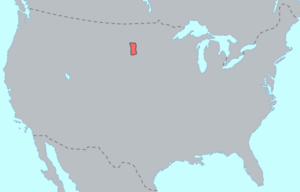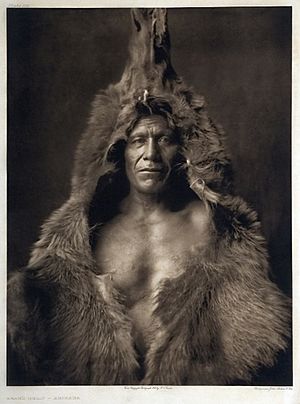Arikara language facts for kids
Quick facts for kids Arikara |
|
|---|---|
| Sáhniš | |
| Native to | United States |
| Region | North-central North Dakota |
| Ethnicity | 792 Arikara (2010 census) |
| Native speakers | 10 (2007) |
| Language family |
Caddoan
|
| Writing system | Latin script |
| Linguasphere | 64-BAA-a |

Arikara language distribution
|
|
The Arikara language is spoken by the Arikara Native Americans. They live mainly on the Fort Berthold Reservation in North Dakota, United States. Arikara is part of the Caddoan language family. It is similar to the Pawnee language, but people speaking Arikara and Pawnee cannot easily understand each other.
The Arikara people were likely the group met by the Lewis and Clark in 1804. At that time, their population was about 30,000. Sadly, a serious illness called smallpox reduced their numbers to about 6,000.
History of the Arikara People
For many hundreds of years, the Arikara lived as a semi-nomadic people. This means they moved around but also had settled homes. They lived on the Great Plains in what is now the United States. It is thought that the Arikara separated from the Pawnee around the 1400s.
An important place from this time is the Arzberger site. It is near Pierre, South Dakota. This site is a National Historic Landmark. It shows the remains of a fortified village with more than 44 lodges.
During times when they were settled, the Arikara lived in villages. Their homes were called earth lodges. When they traveled or hunted bison, they used portable tipis as temporary shelters. The Arikara were mostly farmers. The women grew different kinds of corn, also known as maize. Corn was so important that they called it "Mother Corn."
Traditionally, an Arikara family owned 30 to 40 dogs. The people used dogs for hunting and as guards. Most importantly, dogs helped them with transportation. This was before the Plains tribes started using horses in the 1600s. Many Plains tribes used a device called a travois. This was a lightweight way to carry things.
A travois had two long poles tied to a dog's shoulders. The ends of the poles dragged behind the dog. A frame or hoop was stretched between the poles. This frame could hold loads weighing over 60 pounds. Women also used dogs to pull travois to carry firewood or even babies. Travois were also used to carry meat from bison hunts. One dog could pull a quarter of a bison.
In the late 1700s, the tribe faced serious illnesses. Smallpox epidemics caused many deaths. This greatly reduced their population and changed their way of life. Because their numbers were smaller, the Arikara began to live closer to the Mandan and Hidatsa tribes. They did this for mutual protection.
They slowly moved from what is now Nebraska and South Dakota into North Dakota. This move was due to pressure from other tribes, especially the Sioux, and from European-American settlers. During the Black Hills War in 1876, some Arikara served as scouts. They helped Lt. Col. George Armstrong Custer in the Little Bighorn Campaign.
Today, the three tribes (Arikara, Mandan, and Hidatsa) live on the Fort Berthold reservation in North Dakota.
Current Status of the Language
The Arikara language is now spoken by very few elders in North Dakota. One of the last people who spoke it fluently, Maude Starr, passed away in 2010. She was a certified language teacher. She helped with programs to teach the Arikara language.
Efforts to bring the language back are still happening. As of 2014, the few speakers are mostly in White Shield, North Dakota. The language is taught at Fort Berthold Community College. It is also taught at White Shield School and the Arikara Cultural Center.
The Arikara language has been well-documented. There are several books of Arikara stories with translations. There is also a book for learners and studies about the language. As of 2014, you can find Arikara language apps for iPhone and iPad.
The language was also used in the 2015 movie The Revenant. This film starred Leonardo DiCaprio as Hugh Glass. Hugh Glass was a mountain man who met Arikara people and learned their language in the 1800s.


